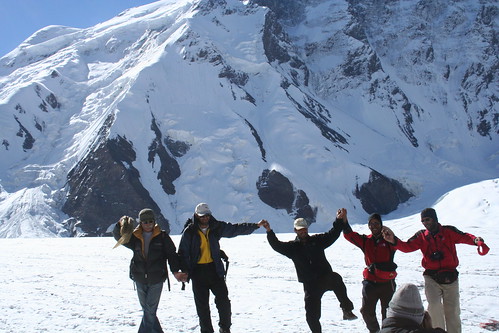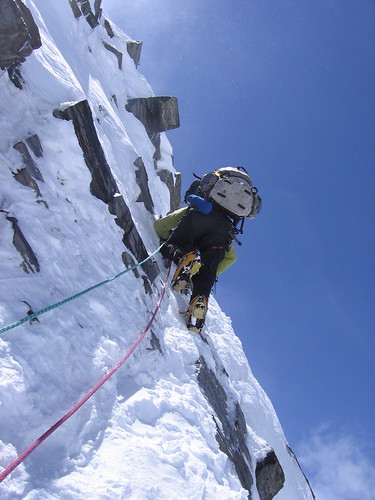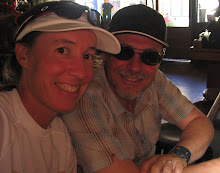Kazakhstan
A snowy pinnacle pointing into the sky, Mt Belukha is Siberia's and the Altai Mountains' highest peak. More importantly, it is, and has been for millennium, a focus of Buddhist and Burkhanist spirituality.
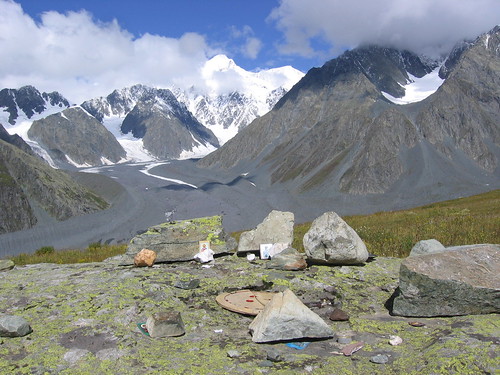 Traditionally called Uch Sumer, meaning 3 peaks, it goes by many names among different Altaian and Kazakh tribes. Archaeologist and some scholars of Buddhist history and philosophy believe that Belukha may be Sumeru, the Central Asian mountain in Buddhist belief that is the center of Shambala (Shangri-la )... where only the spiritually advanced may enter. Belukha is also the headwaters of the sacred Katun River. There are shrines, burial sites, petroglyphs, and standing stones scattered all around the mountain.
Traditionally called Uch Sumer, meaning 3 peaks, it goes by many names among different Altaian and Kazakh tribes. Archaeologist and some scholars of Buddhist history and philosophy believe that Belukha may be Sumeru, the Central Asian mountain in Buddhist belief that is the center of Shambala (Shangri-la )... where only the spiritually advanced may enter. Belukha is also the headwaters of the sacred Katun River. There are shrines, burial sites, petroglyphs, and standing stones scattered all around the mountain.
The Altai mountains are home to the semi nomadic Altai people, and to a renowned diversity of flora and fauna. The endangered Snow Leopard and Argali Mountain Sheep populations have retreated into the safety of these mountains. The Altai people, or Altaians, are closely related to Mongolians and are considered the original Turkic people. They continue to practice Shamanism, Buddhism, and Burkhanism (or Ak Jang, the “white faith”). Burkhanists revere totem animals (argali, wolf, leopard) and totem flowers. They use throat singing at gatherings and in in fire ceremonies. 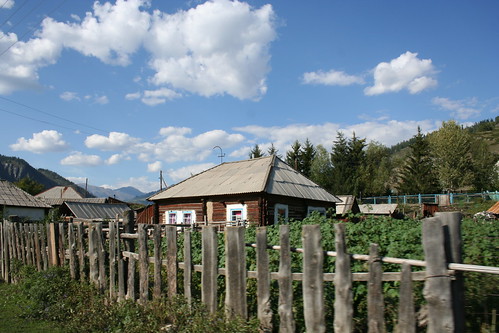
Shambala, as legend has it, is a mystical kingdom hidden somewhere beyond the snowy peaks of the Himalaya. The physical place is said to be in Central Asia, north west of Tibet; a valley in southern Siberia. The name means “place of peace/tranquility/happiness”. It is a “pure land” where all citizens are enlightened. 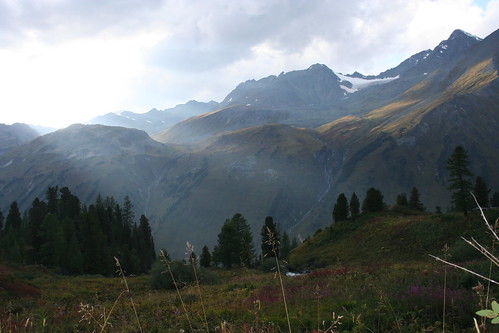 The King of Shambala requested that the Kalachakra tantra be written and taught to other peoples and the Shakyamuni Buddha did this. They say the Kalachakra tantra is still at Shambala; it is a 5 chapter writing that teaches philosophy, practice, and path to attain buddhahood. The name Kalachakra can mean “time-wheel” or “time-cycles”. It is integral to the Tibetan Buddhist tradition. Shambala is mentioned in texts that predate Tibetan Buddhism in Western Tibet.
The King of Shambala requested that the Kalachakra tantra be written and taught to other peoples and the Shakyamuni Buddha did this. They say the Kalachakra tantra is still at Shambala; it is a 5 chapter writing that teaches philosophy, practice, and path to attain buddhahood. The name Kalachakra can mean “time-wheel” or “time-cycles”. It is integral to the Tibetan Buddhist tradition. Shambala is mentioned in texts that predate Tibetan Buddhism in Western Tibet.
As with many ideas in the Kalachakra Tantra, Shambhala is said to have “outer”, “inner”, and “alternate” meaning. The Outer meaning is a physical place, where only people with appropriate Karma can reach. Inner meaning is a pure land that represents itself in your own body and mind. And alternative is a pure land represented in the practice of meditation.
John, Ahat, and Aslan had the 4-Runner ready to load at 7am in front of the hotel in Ust-Kamenogorsk. We drove 10 hours to the farthest eastern and northern corner of Kazakhstan. 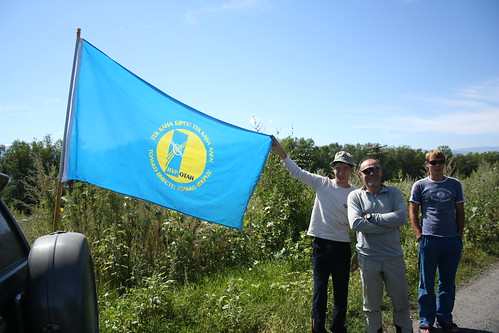 After camping by a lake outside of Rhamani, we started toward Belukha on horse back. We were supposed to leave at 9 am, and go all the way to the “low camp” cabin. It took a bewildering amount of time to sort out the horses (and payment for the horses), so we did not leave until 2 pm.
After camping by a lake outside of Rhamani, we started toward Belukha on horse back. We were supposed to leave at 9 am, and go all the way to the “low camp” cabin. It took a bewildering amount of time to sort out the horses (and payment for the horses), so we did not leave until 2 pm.  Four people with all our climbing gear, on four horses. Needless to say, we stopped for the night at a half-way camp... next to the yurt where the horse man lives (hmm...).
Four people with all our climbing gear, on four horses. Needless to say, we stopped for the night at a half-way camp... next to the yurt where the horse man lives (hmm...).
The next day we sorely clambered back onto our horses and continued to low camp. The flowers and plants in this area are amazing! Such diversity, and so abundant. Interestingly, wild cannabis (yup, wild flowering marijuana) was growing everywhere. The horses LOVED to eat it. My horse, Sultan, really loved it. 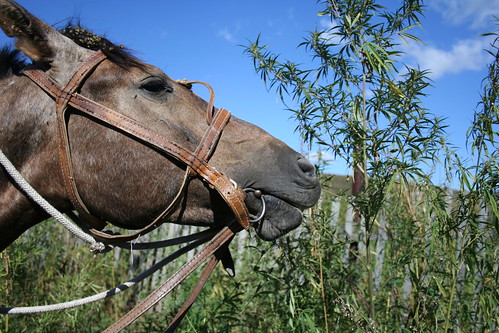 During the ride, I am wondering if after 8.5 hours on horse back, I will even be able to walk, let alone climb this difficult mountain.
During the ride, I am wondering if after 8.5 hours on horse back, I will even be able to walk, let alone climb this difficult mountain.
As we climbed up the final steep section into the high valley under the mountain, a raging waterfall acted like a gate into a wholly different feeling place. Above the falls, it felt more magical, strong energy, there was definitely a sense of power emanating from the place. And just there at the top of the falls was the strangest gnarled amazingly old tree, unlike any other tree... the gate keeper. We clomped along past the tree to the low camp cabin. 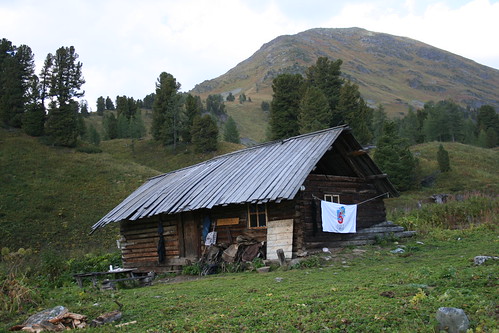
After stoking the wood stove, setting up our beds, and putting out our wet stuff to dry (did i mention it has been raining for two days), I walked back to the old tree. During meditation at the base of the tree, i was amazed to experience the feeling of flow through my solar plexus area with each breath. Energy coming from the tree, through my solar plexus, and outward in a giant cone shape, up the valley toward the mountain, but not reaching it. It felt really good. I have never experienced anything like this before. It was only after getting back to the city that i had the chance to look into this solar plexus thing... i was pretty sure this is one of the chakras on the body, but that is the extent of it. As far as i can find, the solar plexus chakra, or Manipura/Nabhi, is the place of transition from simple or base to complex emotion, energy, and assimilation. It is the place of developing a sense of self through entering spiritual adulthood, power, self esteem, and vitality. It is associated with the fire element, the color yellow, and the lotus flower with 10 petals. It's primary functions are will, determination, assertion, personal power, laughter, joy, anger, and sight. By projecting power through my solar plexus, toward the mountain, it was almost like the tree was gently examining my spiritual adulthood to see if i was developed enough to enter Shambala. Since my cone did not reach the top of the valley, or the mountain, my guess is no, i was not found to be developed enough and could not enter the pure land. But it was not a negative rejection, it felt like a gift.
The next day, we had a brief moment of blue sky, and could finally see the top of the elusive mountain. Beautiful white pyramids.  We set out up the valley, walking along a ridge covered with delicious blueberries, then over the endless rocky moraines onto the endless talus covered glacier. After forever, we got to the top of the glacier, the base of the proposed climbing route.
We set out up the valley, walking along a ridge covered with delicious blueberries, then over the endless rocky moraines onto the endless talus covered glacier. After forever, we got to the top of the glacier, the base of the proposed climbing route.
I say proposed climbing route because the route the 'guide' wanted to climb was almost suicide... a serac gnarled glacier with ice fall certain. At the top of the 12 pitch long, narrow gully of climbable terrain, sat a huge steep-sided bowl of snow, loaded and ready to release into it's only outlet, the route. All of this on top of the actual climbing. Most of the route was fine and had good ice. The problem was two gaping crevasses that extended horizontally across the whole glacier. The 'guide' intended to cross them by jumping (up hill) over them... yeah right. 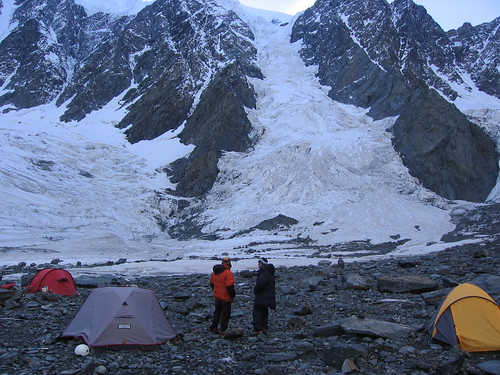
I proposed another route, climbing up a less steep couloir on the other side of a small peak. Turns out this is the intended decent route, and easier (and much safer). We decided to climb this route the next morning. We woke up at 3:30 am and packed our stuff up for a night half way up the mountain. When we got part way up the glacier, not yet to the base of our climb, the weather got bad. Freezing rain sprinkles and wind, and looming dark clouds in the distance. We decided to turn around and try again tomorrow.
It rained all day. In the afternoon the avalanches started. Loud, scary rumblings of ice and rock fall could be heard from the original route glacier all afternoon. Thank god we did not climb that route! We sat imagining being roped in part way up that glacier getting pummeled with falling blocks of ice. It made us feel better that we did not hear or see anything from the couloir route we will climb. 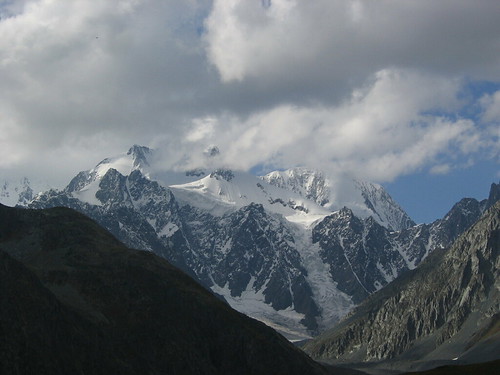 The next morning it was still raining, but clearing up. The snow on the mountain was all wet and loaded, and avalanches were still frequent. We used the satellite phone to call the local mountain rescue and weather info. As expected, they said that the snow was very unstable, especially the top 1000 m because of the wet precipitation and strong winds the day before. We only had two weather days scheduled into our plan, and we had already used them (one the first day, not making it to low camp, and one yesterday). So, stumped again in Kazakhstan, we turned around. John and Ahat went back to the low camp, while Rod and I decided to camp at a beautiful pond at the bottom of the glacier.
The next morning it was still raining, but clearing up. The snow on the mountain was all wet and loaded, and avalanches were still frequent. We used the satellite phone to call the local mountain rescue and weather info. As expected, they said that the snow was very unstable, especially the top 1000 m because of the wet precipitation and strong winds the day before. We only had two weather days scheduled into our plan, and we had already used them (one the first day, not making it to low camp, and one yesterday). So, stumped again in Kazakhstan, we turned around. John and Ahat went back to the low camp, while Rod and I decided to camp at a beautiful pond at the bottom of the glacier. 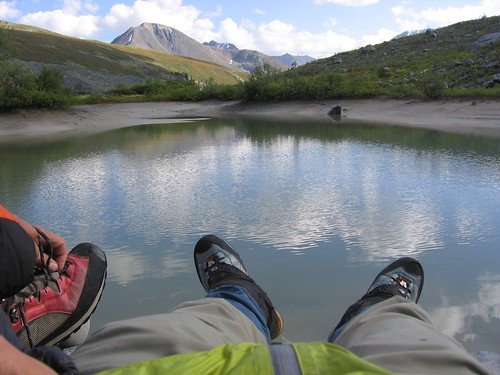
On the way back to low camp the following day, we snacked on wild blueberries and skipped stones in the river. This place is so beautiful; the flowers and herbs, the unique trees, the dramatic mountains, the light. 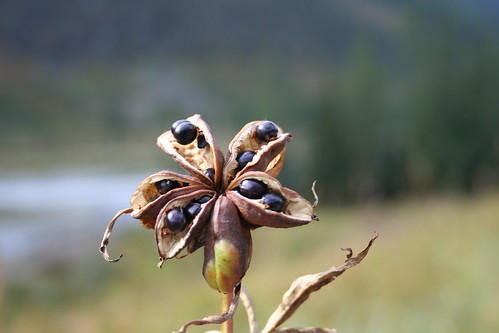 From low camp, we walked to the horse guy's yurt, then took horses back to Rahmani the next day morning. From Rahmani we drove back to Ust-Kamenogorsk the same day, arriving at our hotel late and tired.
From low camp, we walked to the horse guy's yurt, then took horses back to Rahmani the next day morning. From Rahmani we drove back to Ust-Kamenogorsk the same day, arriving at our hotel late and tired.
The next night, we went to the best traditional Kazakhstan food restaurant. The food was great, especially the lahman (hand pulled noodles) with horse meat. As we were ordering desert, a group of about 10 well dressed older ladies came into the restaurant and got a private room (hanging tapestries around a low table with pillows to sit on). After a while we could smell the distinct aroma of people smoking marijuana... the ladies? Yep... after about 15 minutes there was lots of giggling. Classic, the ladies night out and they light up right in the restaurant!
Kazakhstan!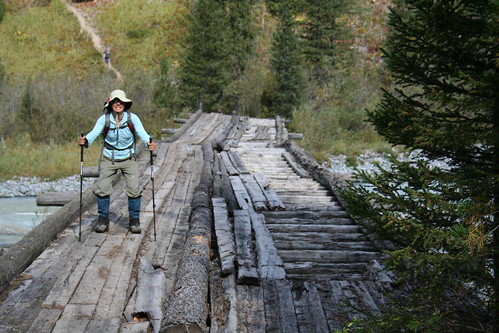
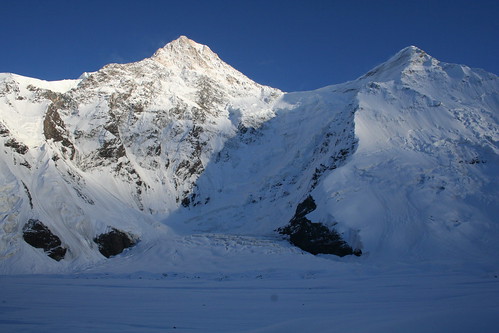 I’m wet
I’m wet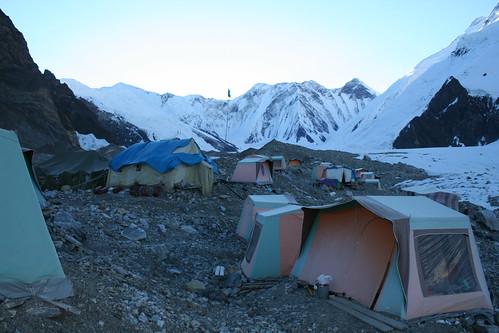 The dining tent is erected directly on the glacier ice (no deck floor) and is filled with 8 long tables, benches, electric lights, and a television with VCR.
The dining tent is erected directly on the glacier ice (no deck floor) and is filled with 8 long tables, benches, electric lights, and a television with VCR.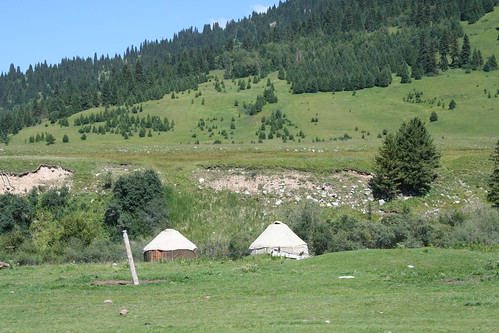 Along the way we passed countless yurt camps with their herds of horses, bee hives, and 4WD trucks. I guess we crossed into Kazakhstan when we crossed the river to the heli camp, but there was no border control or even a sign.
Along the way we passed countless yurt camps with their herds of horses, bee hives, and 4WD trucks. I guess we crossed into Kazakhstan when we crossed the river to the heli camp, but there was no border control or even a sign. One group of Spaniards told us that they had been caught by a snow storm for 5 days at camp 3 (5800 m) and only had two days of food. Luckily, they found some food left in a snow cave… mental note: this is a real mountain, and we need to take it seriously. Almost everyone coming back from base camp had bloody lips and blistered faces, either from frostbite or sunburn.
One group of Spaniards told us that they had been caught by a snow storm for 5 days at camp 3 (5800 m) and only had two days of food. Luckily, they found some food left in a snow cave… mental note: this is a real mountain, and we need to take it seriously. Almost everyone coming back from base camp had bloody lips and blistered faces, either from frostbite or sunburn.
 It had snowed there all morning and the camp was a village of white atop one of the biggest glaciers I have ever seen. Beautiful views of the mountain with its pyramid top of pink marble.
It had snowed there all morning and the camp was a village of white atop one of the biggest glaciers I have ever seen. Beautiful views of the mountain with its pyramid top of pink marble. The climbing is steep, from 45 to 75 degrees, and mixed snow and rock. We were relieved to find out that the ropes from camp 2 up to the summit are newly replaced and in much better condition. The climb is a Russian grade of 5b (on a scale of 1a to 6b), or TD on the French mountaineering scale.
The climbing is steep, from 45 to 75 degrees, and mixed snow and rock. We were relieved to find out that the ropes from camp 2 up to the summit are newly replaced and in much better condition. The climb is a Russian grade of 5b (on a scale of 1a to 6b), or TD on the French mountaineering scale. 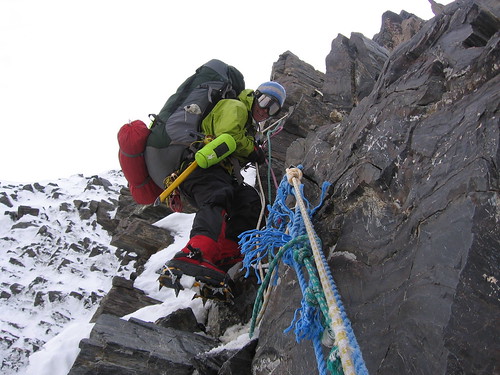
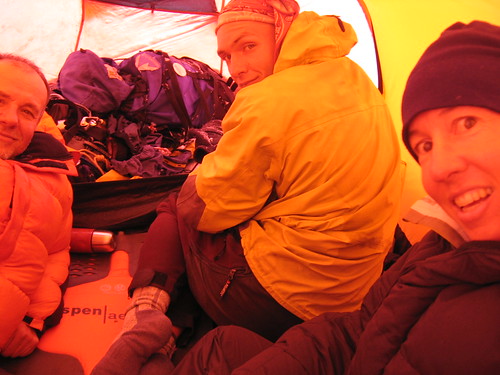

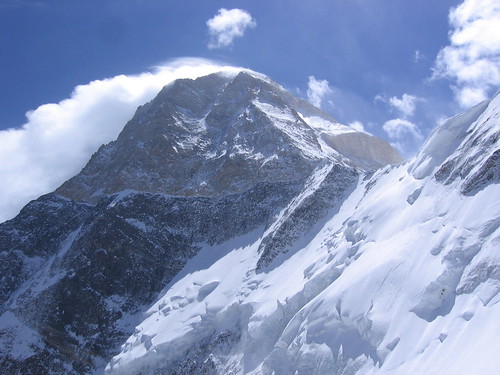 The peak had a wind-formed cloud on one side of it and gusts were making me stumble as we walked up the first pitch from camp 2. After we crossed a knife edge ridge, we stopped to assess the situation. We had received, a few days ago, a weather report from Seattle that a low pressure system will move in tomorrow. It was highly likely we could get to camp 3 and be sitting there in a storm for 3 or 4 days. Rod and I brought food for 5 days, but when we asked Kiril how much food he had, he said only two days (how can a guide on a mountain like this not bring any extra food incase of emergency or bad weather?!!). We decided to go back to camp 2 and get an updated forecast and reassess.
The peak had a wind-formed cloud on one side of it and gusts were making me stumble as we walked up the first pitch from camp 2. After we crossed a knife edge ridge, we stopped to assess the situation. We had received, a few days ago, a weather report from Seattle that a low pressure system will move in tomorrow. It was highly likely we could get to camp 3 and be sitting there in a storm for 3 or 4 days. Rod and I brought food for 5 days, but when we asked Kiril how much food he had, he said only two days (how can a guide on a mountain like this not bring any extra food incase of emergency or bad weather?!!). We decided to go back to camp 2 and get an updated forecast and reassess.  We have to be back at base camp on the 17th at the latest, and today is the 10th. Back at camp 2 again! Kiril got to the camp before us, disappeared into his tent, and didn’t say a word to us for the rest of the day. We hung out and talked to climbers coming down in the afternoon. Yesterday 3 people summitted! But they said it was VERY COLD, and it took 17 hours round trip (camp 3 to summit to camp 3).
We have to be back at base camp on the 17th at the latest, and today is the 10th. Back at camp 2 again! Kiril got to the camp before us, disappeared into his tent, and didn’t say a word to us for the rest of the day. We hung out and talked to climbers coming down in the afternoon. Yesterday 3 people summitted! But they said it was VERY COLD, and it took 17 hours round trip (camp 3 to summit to camp 3). 
